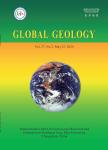Cretaceous Environments of Afghanistan:A Synthesis Based on Selected Sections
Cretaceous Environments of Afghanistan:A Synthesis Based on Selected Sections作者机构:Institute of GeosciencesUniversity of TuebingenCentre of Advanced Study in GeologyPanjab University TuebingenD-72076 GermanyChandigarh160014 India
出 版 物:《Global Geology》 (世界地质(英文版))
年 卷 期:2003年第8卷第1期
页 面:1-13,19页
学科分类:070903[理学-古生物学与地层学(含:古人类学)] 0709[理学-地质学] 07[理学]
主 题:Cretaceous, Afghanistan, biostratigraphy, palynology
摘 要:The Cretaceous of Afghanistan is marked by great facies diversity. The evolution of Cretaceous basins is part of a complex accretionary history involving three distinct tectonic units namely the Asian ( Russian) Block separated from the Indian plate by a rather well defined transcurrent fault (Chaman-Nuski). The southwestern component is represented by the Iran-Afghanistan plate. The Lower Cretaceous of the Asian Block is represented by the Red-Grit Series which is conformable to the underlying Upper Jurassic sequences. The transition is marked by evaporitic facies dominated by salt, gypsum and marl deposits. In south Afghanistan volcanic rocks occur at Farah, with the emplacement of plutonics in west-central Afghanistan. The Upper Cretaceous of north Afghanistan is marked by richly fossiliferous, limestone-domi-nated sequences. The Upper Cretaceous of southern Afghanistan is marked by strong ophiolitic magmatism.



